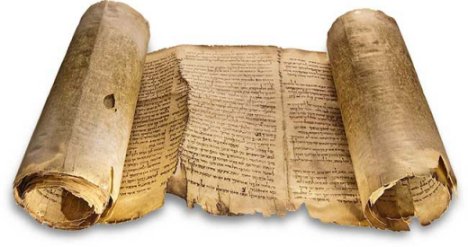
A. Discovery of the Scrolls
The Dead Sea Scrolls (DSS) are the remains of a collection of more than 800 biblical and mostly religious manuscripts (MSS) found at Khirbet Qumran ('the ruins at Qumran') and six other sites along the western side of the Dead Sea from 1947 to 1956. The majority of the texts are inscribed on leather (i.e. animal skins), but some are on papyrus, and one (3Q15) is on copper. Most are in the Hebrew language, about 20 per cent in Aramaic, and a few in Greek. The script for the most part is the Jewish 'square' or 'block' script, about 16 are in the ancient Phoenician, or Paleo-Hebrew, script, all being the books of Moses (Pentateuch), Joshua or Job. There are also some rare examples of a cryptic script.
Near the Qumran caves where the Scrolls were found, a building complex was excavated, and it has been widely acknowledged that the Scrolls belonged to a group centered around the building. Three cemetries were adjacent, the closest holding about 1,100 graves aligned south-to-north with the head at the south. Of the few excavated, only males were found in the closest, but there were remains of women and children in the other parts. The date of the building and that of the MSS are determined by a combination of factors, including coins, pottery, palaeography, and accelerated mass spectrometry:
- 1. The coins unearthed in the excavations of the building date from Antiochus III (223-197 BC) to the third year of the Jewish Revolt (68 AD);
- 2. The type of pottery characterising the jars in which a few of the MSS were intentionally desposited in Cave 1 is similar to that of the jars and a large collection of bowls stashed in a pantry in the main building. It dates from the last centuries of BC and the first centuries AD;
- 3. The paleographic date of the MSS in the Qumran caves, established by study of the scripts used in copyting the MSS, extends from about latter half of the 3rd century BC to about the middle of the 1st century AD, though at Murabba'at it extends to the first third of the 2nd century AD. The early dates indicate that many scrolls were brought in from elsewhere. Some texts found at Khirbet Mird written in Arabic date as late as the 7th century AD; and
- 4. Accelerated mass spectroscopy is a system, more advanced than Carbon-14 dating, for determining the age of ancient artifacts. Two tests were performed on a series of scrolls, including some which bore absolute dates in the hand of the original scribe, and the range of dates of the revelant MSS was 388 BC - 68 AD (the First Jewish Revolt), with the finds at Murabba'at extending to about 135 AD (the Second Revolt).
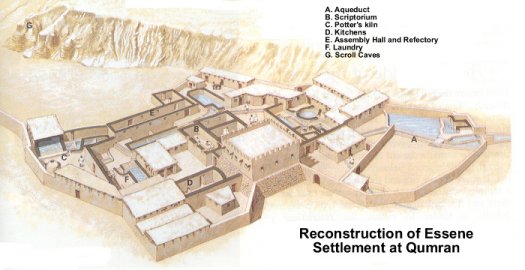
Though the abandoned site of Khirbet Qumran had long been known, the first MS discovery was at Cave 1 by Arab Bedouin in 1947. Cave 1 is about 1.7 km (1 mile) morth of the building, in the limestone cliffs towering above the littoral plane. Seven scrolls were found:
- 1. One complete scroll of the book of Isaiah (1QIsaa), wrapped in linen and enclosed in a tall sealed pottery jar, as well as extended fragments from other scrolls including,
- 2. A second copy of Isaiah (1QIsab);
- 3. The Rule of the Community (1QS);
- 4. A Pesher or Commentary on the Book of Habakkuk (1QpHab);
- 5. An imaginatively developped narrative work based on Genesis (the Genesis Apocryphon, 1QapGen ar);
- 6. An apocalyptic War of the Sons of Light Against the Sons of Darkness (1QM); and
- 7. A collection of Hodayot (Hymns of Praise) composed within the community (1QH).
In subsequent scholarly excavations of Cave 1 (directed by Roland de Vaux), small fragments from an additional 72 MSS were unearthed. These includes MSS of biblical books and commentaries on biblical books, as well as apocryphal, legal and liturgical texts.
Ten more caves were found at or near Qumran. Cave 4, discovered in the immediate vicinity, was the richest, yielding fragments of about 580 scrolls. Cave 7, equally close, contained only Greek papyrus fragments, including Exodus and the Letter of Jeremiah. Cave 11 was the last discovered in the Qumran area, in 1956. Additional caves were found a few miles south of Murabba'at, containing letters of Simon bar Kokhba and other documents from the Second Revolt, as well as at Nahal Hever/Wadi Seiyal, and Khirbet Mird. Finally, atop the mountain fortress of Masada a mixed collection of more than 50 texts were recovered, including part of the Book of Sirach in Hebrew.
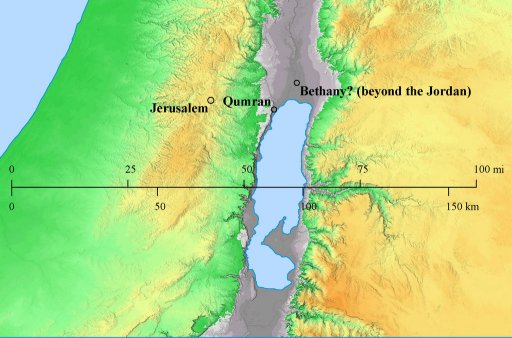
B. The Scrolls and the Tanakh
Indicating the importance of the Scriptures at Qumran, more than 200 scrolls, about 25 per cent of the more than 800 found, were MSS of biblical books. Every book of the traditional Tanakh (Old Testament), except Esther (see Purim) (and Nehemiah if considered a separate book from Ezra), is represented at least minimally. The most frequently attested books were Psalms (39 MSS), Deuteronomy (32), and Isaiah (22) - not surprisingly the three most quoted books in the Messianic Scriptures (New Testament) as well.
Previously, the oldest extensive Hebrew MS available was from the end of the 9th century AD. The Scrolls are older by a millennium. From the earliest days come two of the most important learnings about the biblical text. First, 1QIsab showed that the traditional text known from the Masoretic Text (MT) had been very faithfully copied over the centuries from one ancient form of the text. Second, 1QIsaa showed that there were variant forms of the scriptural text circulating in antiquity prior to the era of a uniform text. Whereas 1QIsab normally exhibited only minor variants vis-à-vis the traditional MT, 1QIsaa displayed thousands of differences in spelling, word forms, textual variants, and cases of much longer or shorter text.
As the biblical MSS (now mostly published in the 38 volumes of the series Discoveries in the Judaean Desert) were analysed, this pattern continued to reveal itself in ever more elaborate and instructive ways. Prior to the 2nd century AD, when the proto-MT form of the collection of Scriptures became the only textual form transmitted in Hebrew, the text was pluriform, many books even displaying two or more literary editions. Numerous textual variants pepper all the texts, sometimes showing errors or expansions, but at other times providing superior readings where the MT has erred or expanded; thus many Qumran readings have been incorporated into revised translations of the Bible (e.g. the NRSV). The Scrolls also validate the Septuagint (LXX) and Samaritan Pentateuch in general as faithful witnesses to an ancient Hebrew text that may have been more accurate than the textual form transmitted in the MT.
C. The Scrolls and Judaism
The Scrolls have greatly illuminated and changed scholars' understanding of Judaism at the turn of the era. Whereas it was once thought that there was a single, 'mainstream' or 'normative' Judaism, it is now clear that Judaism was richly pluriform. There were a variety of parties and a wide variety of views on any number of subjects, and no particular group held full authority in teaching or practice over the others, though the Jerusalem cohenim (priests) probably held the strongest claim to the average person's loyalty.
DSS expert Schiffman, Professor of Hebrew and Judaic Studies and the Director of the Global Institute for Advanced Research in Jewish Studies at New York University, wrote:
"Scholars used to think that the library was entirely the product of the inhabitants of Qumran. Instead, it can now be stated, this hoard of manuscripts includes material representing a variety of Jewish groups as well as polemics against other Jewish groups."
The Essenes, as a movement within Judaism, had previously been known only through brief descriptions written for foreigners by Josephus, Philo, and Pliny. While Josephus may have gained first-hand knowledge of the Essenes, Philo and Pliny were probably working from sources. Thus, though these descriptions help identity the Qumran group as Essene, they do not provide a standard for understanding the group's beliefs. The Scrolls themselves provide abundant correction and amplification to our knowledge of the Essenes, which, though still imperfect, now exceeds our knowledge of contemporary groups, the Sadducees, Pharisees and Zealots.
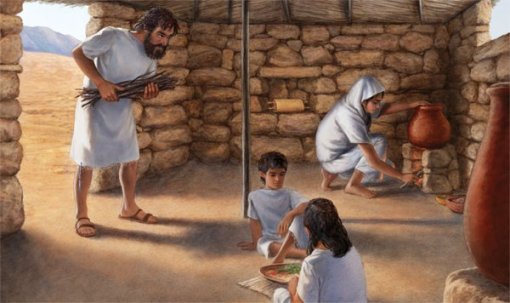 Essene life at Qumran
Essene life at Qumran
The Essene movement predates the Qumran community, though its origins are not fully known. During the Maccabean period, they were led by someone called the 'Righteous Teacher' or 'Teacher of Righteousness'. The Teacher, himself a cohen (priest), came into serious conflict with the leaders in Jerusalem, possibily over the legitimacy of the high priesthood, since the Maccabees installed themselves in that office in place of the traditional Zadokite cohenim (priests), and the Teacher was forced into exile from Jerusalem. In time, the group settled in the wilderness at Qumran, to study Torah and so "prepare the way of Yahweh" (1QS 8:12-16; Is.40:3).
The Scrolls reveal a dualistic worldview. There were two ways - one of light and good, the other of darkness and evil. The community believed that history was predetermined by Yahweh, and that they were part of the remnant of true Israel, living under a 'renewed' covenant with Elohim (God), in continuity with the covenant of Sinai, but with a deeper understanding of, and incentive to, obedience.
In their view, like that operative in the Messianic Scriptures (New Testament) as well, Scripture was written in symbolic, obscure language by nevi'im (prophets) who may have understood one level of meaning in what they wrote but did not understand the ultimate meaning, which was revelation about the 'end time'. The true meaning of the text was allegedly revealed, however, to the Teacher of Righteousness. The Scriptures referred to the Essenes' own period, the "latter days" (e.g. Dt.4:30; 31:29; Is.2:2; Mic.4:1, NKJV) and described the events they themselves were experiencing, such as the exiling of the Teacher and Roman rule. As such the Essenes are representative of any sect, ancient or modern, that has become separated from the 'mainstream', and we see in them likenesses to many contemporary denominations.
The Scrolls refer to other Jewish groups. They discuss conflicts with "the seekers of Smooth Things" (probably the Pharisees) and "Manasseh" (probably the Sadducees), as well as conflicts over the high priesthood and the calendar. Some early scrolls, including the Halakhic Letter (4QMMT), contain halakhic views in common with the Sadducees, probably reflecting the group's roots in the Zadokite priesthood. Views on other subjects, however, such as predestination and resurrection, are strongly opposed to Sadducean views. The Qumran Essenes lived a life of strict observance and greater asceticism than did other groups, but it is not thought they excluded other groups from the true Israel on that basis. In that respect they were not unlike modern Protestants.
D. The Scrolls and the New Testament
The community at Qumran was destroyed before most of the Messianic Scriptures (New Testament) were written, and no scrolls contain New Testament texts, though some unpersuasive claims of such have been made (such as claims that 7Q5 contains the Gospel of Mark). Nor is there any reference to Yah'shua the Messiah (Jesus Christ), John the Baptist, or anything specifically Christian or Messianic. Nevertheless, because similarities in language, theological themes, characters, texts, and practices are pervasive, the Scrolls provide inexhaustible illumination for understanding the text and world of the Messianic Scriptures (New Testament) and early Christianity.
The Scrolls reveal a common Jewish root in self-defining community practices, such as community property shared in common, a ceremonial sacred meal, and ritual bathing (mikveh) for purity.
The complex of messianic views characteristic of this period is further revealed in the Scrolls. More than one messiah is envisioned - a priestly and a kingly messiah, who are accompanied by a prophet: "...until there come the prophet and the messiahs of Aaron and Israel" (1QS 9:11). The kingly messiah was to be a victorious war hero, like David, and to rule with wisdom and justice, as prophesied in Isaiah 11:1-5. The priestly messiah was still higher in authority. Clearly the Essenes confused the two comings of the one Messiah and got them the wrong way round. Yah'shua the Messiah (Jesus Christ) as king is a theme throughout the Synoptic Gospels (Matthew, Mark & Luke) whilst Hebrews speaks of Messiah as a cohen (priest), though after the order of Melchizedek, not Aaron, and a minister of the heavenly sanctuary (Heb.8:1-2; 10:12-14).
A great deal was made by the Essenes of the so-called 'Pierced Messiah' text, 4Q285, which was initially misread and thought to describe a messiah who is killed. More careful reading, however, reveals that the text names Isaiah, quotes from Isaiah 11, and here describes a Davidic messiah who kills someone else, as in Isaiah 11:4, where the Davidic ruler kills the wicked. Of course, the resurrected Messiah does this at His Second Coming, which the Essenes did not understand, and accordingly, since He did not fulfill their expectations, were unprepared for the true Messiah when He came.
In addition to 'messiah', several other titles are used similarly in the Scrolls and the Messianic Scriptures (New Testament): "branch of David" (e.g. 4Q285 frag.5:3; 4QFlor col.III:11) is similar to "Root of David" (Rev.5:5). A striking parallel in terminology to Luke 1:32,35 occurs in the fragmentary 4Q246, which reads, "He will be called 'the Son of Elohim (God)'". However, though this figure was at first hastily claimed to be a positive messianic figure, the DSS context rather suggests a wicked leader who arrogates to himself divine status. The satanic Psyop should be obvious.
Like the Messianic Scriptures (New Testament), the DSS place messianic expectations in a dualistic (light/darkness), eschatological framework (cp. 1QS 3:13-4:26; Jn.1:2; 2 Cor.6:14-7:1). Both read texts from the Tanakh (Old Testament) in an eschatological and contemporising manner. The Scrolls and the Messianic Scriptures (New Testament) also show a reverence for the same Scriptures: the Torah (Law) and the Nevi'im (Prophets) plus a still undefined collection of other books. They even emphasise the same texts: the Psalms interpreted prophetically, Deuteronomy and Isaiah. But Enoch and Jubilees were both probably considered among the authoritative books of the Essenes, whereas the Wisdom Literature is sparcely attested, and as noted, Esther was entirely absent.
In contrast to the earlier flat view of a distant Christianity versus a clearly defined 'normative' Judaism, the commonalities between the Scrolls and early Christianity/Messianism demonstrate how thoroughly Hebraic are the roots and development of Christianity. The Scrolls show a wide and diverse spectrum of beliefs and practices in the first century Judaism that was the backdrop of the rise of the Messianic Community (Church).
E. False Essenism and the Gutter Press
As a footnote, it needs to be emphatically stated, that the DSS and Essenism have nothing to do with the Gospel of the Holy Twelve, the Gospel of the Essenes or with modern 'Essene Christianity' in general which is a branch of the New Age Movement that has simply put a veneer of Christianity on top and incorporated New Age ideas like reincarnation, faking some gospels to lend itself credibility with which to deceive Christians. Neither has it anything to do with modern occultic 'Nazorean Essenism' which arose out of Mormonism, Gnosticism and Egyptian mysticism.
Finally, the reader should be aware of a highly biased, unscholarly, atheistic, anti-Christian sensationalist pot-boiler by journalists Michael Baigent & Richard Leigh, The Dead Sea Scrolls Deception (1992), the authors (with Henry Lincoln) also of other unreliable anti-Christian books like The Holy Blood and the Holy Grail (1982) and The Messianic Legacy (1986), which is more likely to be in the hands of the layman because of its easy availability than any truly scholarly work (see the Bibliography below).
Conclusion
The discovery of the DSS is a priceless addition to our knowledge of the Judaism of the beginning of the common era. Far more MSS have, unfortunately, been lost than found, many of the MSS having been used for lighting fires by their bedouin discoverers before they realised their value, and others having doubtless ended up in private collections where they are unavailable for scholarly scrutiny.
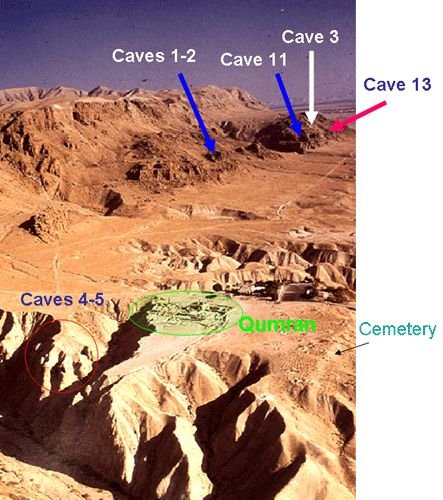
Altogether, between 1951 and 1956, 11 caves yielded a treasure trove of MSS. A 12th cave was discovered in 2017 but the broken and empty scroll jars and pickaxes suggest that the cave was looted back in the 1950's and no one now knows what they once contained.
The chief value of the DSS to Messianic Evangelicals lies in our having the oldest known Tanakh (Old Testament) MSS to work with, predating the much later and occasionally corrupted anti-Messianic/Christian Masoretic version that nearly all English language Bible Old Testaments have been based on. (24 November 2017)
Bibliography
[1] John Allegro, The Dead Sea Scrolls: A Reappraisal (Penguin, Harmondsworth, Middlesex, England: 1975)
[2] G.Vermes, The Dead Sea Scrolls in English (Penguin, Harmondsworth, Middlesex, England: 1976)
[3] Geza Vermes, The Dead Sea Scrolls: Qumran in Perspective (Collins, London: 1977)
[4] Robert H.Eisenman & Michael Wise, The Dead Sea Scrolls Uncovered: The First Complete Translation and Interpretation of 50 Key Documents Withheld for Over 35 Years (Element, Shaftesbury, Dorest, England: 1994) - it should be noted that the authors are anti-Christian, their commentary reflecting that bias. Eisenman, in his books, James the Brother of Jesus (2002) and The New Testament Code (2006), reflect the liberal-secularist attempt to discredit the authority and reliability of the Bible.
[5] The Leon Levy Complete Digital Archive of the Dead Sea Scrolls (Israeli Antiquities Authority)
|


